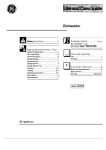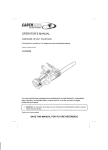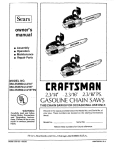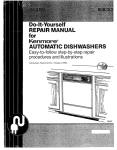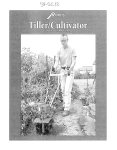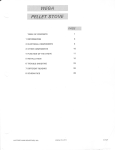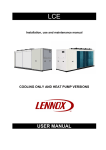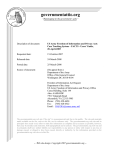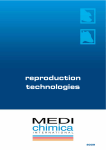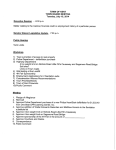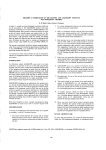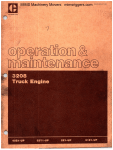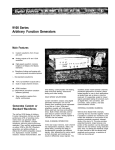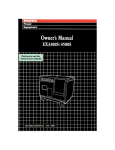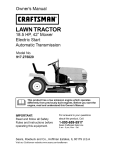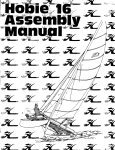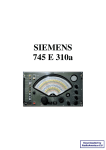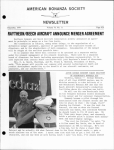Download THEORY AND MAINTENANCE
Transcript
THEORY AND MAINTENANCE
RECIPROCATING ENGINES ORAL
1.
How are conventional reciprocating' engines classified?
They are classffled according to cylinder arrangement with respect to the crankshaft (in-line, Vtype, radial and opposed), or according to method of cooling (liquid cooled or air coaled).
2.
What are the different types of piston rings?
Compression rings, oil control rings, and scraper rings.
3.
What is the purpose of the oil control rings?
They are used to control the thickness of the oil film on the cylinder walls.
4. What may be the result of installing piston rings incorrectly?
Excessive all consumption.
"
5. What type. of piston rods are commonly.found in radial engines?
;?
Ama§ter and artituliltingrcd assembly.'
i"
6.
What type bearings are in general use in reciprocating engines?
Plain bearings, which are generally used for crankshaft, cam ring, camshaft, connecting rods,
and accessory drive shaft bearings. Roller bearings, which are used primarily as crankshaft
main bearings, but have other applications as well. Ball bearings, Which are used for
supercharger impeller shaft bearings, rocker arm bearings in some engines, and as propeller
thrust bearings.
7.
What Is the Indication of valve blowby?
Valve blowby Is Indicated by a hissing or whistle when pulling the propeller through prior to
starting the engine. A cylinder compression check should be made to Identify the faulty cylinder.
S.
What is the purpose of using more than one s'pring for valve closing?
If only one spring Is used to close the valve, It will vibrate or surge at certain speeds. To
eliminate this difficulty, two or more springs, one Inside the other are Installed on each valve.
Each spring will vibrate at a different engine speed, and the spring surge vibrations will be
dampened. Twoer more springs also reduce the danger of weakness and possible failure by
breakage due to heat and metal fatigue.
9,
What Is the purpose of valve overlap?
Valve overlap permits better volumetric efficiency and lowers the cylinder operating
temperatures.
66
1O. Describe the inspection you would give.theyalyespring~ durlrrg· engine overhaul.
TheyshoulcjlJe cleaned thoroughly, af1(f th~n visu,~lIy Inspected for evidence of overheating,
cra~ks,bro.ken end~, <l~P fqr cornpre,s~lq!l stre.nWtl.
•."
•••.
'.'
•
,-
.,.,
.
:.- •
-
0'
-,
11. What is the purpose of using valves with sodium filled stems?
Some intake and~xha'ust valve iiteTl1~ are hollow and partially filled wtth metallic sodium.
_s,ogl.Y!11'!~i~&7<1,~~qeY,~3 itl~j~Q~~c~!le'J~~JllltjeRP;,ductop ,.h!! .sQdI,urn.meltsat aboU\208'F.,
and' the' movement of-ttie valves circulates the liqUid sod 10m which enables.INocarr.y the heat
from the valve head to the stem, where. it Is dissipated through the valve guide to the cylinder
head and cooling fins.
.
12. What
~u~es engine sUd'aej;isio~d~~t?:' .
. .il ':
StrIking an object or engine seIzure due to Intern'll gamage.
,
.';
j'.
.
>
••
~~-':.-'
·':"·-'c::-f.r·"··~:·
I
'''~'-,:.>' ",1",.·.-,
13. What type inspection must be made after sudden st9Ppage of, <;1(1 engine. Oll.El !o ~riklng!lrid object?
.
.'
'.
."':, ... ,;--.-..: .... :- ' .:' ..:'. ;._:
.' :~;:":;.. .:." .,; .. ".-' ,,~.. '-' -' :.' ; .. _.,.:.
'-",
-'-
' . '
.
The propeller drIve shaft must be checked for misalignment, a[1d the. prqpElRe.r clWc~ed for track,
'..
. ...
. '.
·f·'··:" :i....".:., ,-,,:,r,_:, . ,,;,
.-
:>.:
- ";".,- -,
14. What is the purpose of crankshaft dynamIc dampers used in aircraft engInes? .
::;: ,.-Z-.i.' : "., """:~"'~" '-:--':.1"
""·\'-'.·-;·.::-'t/.~.~:·.-:,
i-'
"~.,
';_.c,;' ":<;"":,<::',1
'-':
,';"
Dampers are used to overcome forces whIch cause deftl:ictloh 6hhlrt:tanksh<;lft anJ,f tqrsJol1<;l!
vibration, These forces are generated ,bythepoyier irnR~I~.~spf\~ep'fl(otfs:' ..¢rnfi~s~~f('.":""
vibtatIi:ms ,!re redt/qed by placingfloaliiig' damper§(welght's).·IntHE!C9J;l~f~J~eijjfit ~~EfIJl6Iy,
partfculai1y'in'a' siiiglifthrow type crankshaft·,··,-,· '.' ". .- " ....." J.' •. " ' .-'--" .
::1
15. HowweOldyou.. milk-S:ii 'riinbuil':tlisckoha'cfahkshaff ih1filii·siilf·iii$t~lred:iri;itl.Ei~~~l!1e.J. '.'
"- ""::.;3:,' :':'.' :..-.~~':.: ';:-C<"
" .. , . -,' :-."
,',
Remove thepropellEir'ftbmthe shaft and'attacha dial Ind\cator"-gtt~e to.the front of the
crankcase, Adjt:lstthe po~itionof the gage needle-s9 ttiatll)s tbuchlhg tlie shaft Tum the
engine through'with the starter and riote any changes in the gage 'r'eiacji'rig,
,... : .. ' . ,
".'
. - . ' -.'
.>::.. " .,
" ..~. '.
"',.-.,
16. What is detonation?'
Normal combustion Is when the fuel'air mixture bums at a uniform rate across the combu~tiQn
chamber. The temperature and pressure within tI1ecy(rnder ris-es'iira ndhii·alrn.fe,as tfle'jTI'&!ure
bumS, All fuels" havecriiicilf Iimits'bHempeb:itlirei"arid compressidtl and beyond this limit they
will Ignite spontaneously an~ burnwitti exp!oSiVevi6ien.c9: This iri~al1,\8Ij~ol,J.se~ptosiVe~ujr]ing
of the last portIon of the chat!ie'is-caUed'qetonaliort ' .
" " " , •. '. . ' .
"l
•• :
~.
".
•
'-. ' j
.-,
~: 17. During valve cleal'ilnceadj~sth1entO'rr llrrR'28QI;l engIne;. WhY'rmist yoll depreiis certalri valves oiher
than the ones beIng adjusted? .....
'..
..
.
.
'''...
_.'
.."
"
.
. '
.
The valves mllst be depressed (uriloaded)' In order to remove the spring ienslon frolTl the side
positions on the cam and thus permit tHe cam to slide away from the valves to be adJllst9!lllntii
it contacts the cam bearing, This prevents' cam shift from Introducing errors in th"S Clearance
settings.
18.
Whatca~ beleamedabout the condition of an engine by studying ihe results of a compression
check?
From the cylinder compression check you can determine if the valves, piston rings, and pistons
are adequately sealing the combustion chamber.
.
67
19. How can a cold cylinder be located on a double row radial engine?
A cold cylinder check can be made with a cold cylinder Indicator. sometimes called a 'magic
wand'. to locate any cylinder that has a temperature lower than the normal operating
temperature of the other cylinders.
20. What Instrument can be used to check a cylinder bore for out of roundness?
A'cylinder bore can be checked with dial indicator. a telescopic gage and micrometer. or an
inside micrometer.
RECIPROCATING ENGINES PROJECTS
1. Check piston rings for correct end and side clearance .
. 2.
Check valve stems for stretch using a contour gage or micrometer.
a seattle allJminurn piiton.
3.
Repiiir
4.
locate' and Ihspect engine mounts in accordance with reference material.
5.
6.
Adlli§fen.9ih~ ofpr!iss~rein<'\ccorda'ryce with reference rnaterial .
.'. ," -r''''::: -. .- .,:
"".-:~: - :";'.f<': -,-'-
'>.- :'_.. : .. ,.. ;" .;: " . _: '.' - -..~' -;~,
•
Demonstrate correct engine starting procedures.
7.
Operate !in erygin'e,throug\lout"thenormal operating range and check for proper operation in
ac;corqance 'with the, operating instructions.
.
8.
Use~p?!~(cylln~\'!r.}IJPl~liItor~\Id)!;>qat~ (l.colgcyllt)8er<'\fteran 8rlglne runuP·
9.
'i,', '": -;"
.
~. ,":' .~.-: ..<j.:
""-: ..:.> ':.~
;.;
Usil1gref~rence mat~ri<'\l. ,correctly remove
10.
C6rr~stly!p~ritifyanthe part~ ~f an air cooled
••• ' -'r
• ',' -~ ': \ ".
'.
, , ' . ' - •• ."':, -- • ,
.'
-. •
•
•
'.
'," ,:;. .' ',':"- ',; :-. '-:.
and reinstall a propeller.
11'_,~~~f~~J4f~~W;~rth~~J,~,6!:a~~nk;,~~~"
cylinder.
.. ,..
. '. ',.' "
. .... '
12, .8si.~!(t!lter~i,j,c~.m~l~r!~!,)J]sP.~q~<'\"c;r,a,n~SM'tixecord,.the ,d~mensiol1s.' and determine' it the
cra~sl"1aft ls.""ithln.,toleranceto meet retum,to.servlcequaljty." "," . . , ' .."'. >,.,';' ,''''
13.S:l?rrf;lcMl[,/C;I,~l1tj.fy va.rIo,,!s types 2f,bf;larlngsand determine .If· they are return to service quality.
.,
.'
14. Measure
,
.
t/;lE! inside.diameter. taper. <lnd
_'7,'.
.
"
..
out-of-round of a cylinder i?o~e and determine If It is return
. ~:::~~~~'~~~':~~;~~.~'~~_:' .:~ ,'.'.~:';' .::,:;<', ,.. ~ .' ," '." :' :-,' '.
.> . '.
i.'
~, '~'~1'
"-,'.,
.. ":
.i':;: -';.
_~
.::
.~:-
15'U~!n~l~~tfiI:i(t!'l:ip~fe:d~.}fi!i\9k. apd .adJ\Jst.v~lvf;lclearances wlthin'thecgivenJiI:nlts. ',.' .
16. CorreCtiy disassemble an articulating rod from a master rod assembly. and reassemble according to
mamj/apturer.s
instructions.
,.,.
-' '. . ,. ,''- .
',.\~
17.
Adju~t:a
mechanical push-pull control system in accordance witil reference material.
18. thsfitll a plstor]'':'ln. a knuckle
pl~, a~d the retainer without damag~;~;he co~ponents.
68
TURBINE ENGINES ORAL
1. What are the major components of a typical gas turbine engine?
·'
A typical gas turbine engine consists of an air inlet, a compression section, a combustion
section, a turbine section, an exhaust section, and the accessory section.
2. What are the two principal types of compressors used in turbojet aircraft?
The two most common compressors in use today are the centrifugal flow and the
types.
axial flow
3. What are three types of combustion chamber systems?
They are the can type, the can-annular type, and the annular type.
,
4. What is the purpose of the Interconnector tubes between can type combustion chambers?
To spread the flame to the combustion chambers that are not equipped wtth igntter plugs during
engine starting.
5. What prevents burning of the liner walls in can type combustion chambers?
Louvers are provided along the axial length of the liners to direct a cooling layer of air along the
inside wall of the IIner_
6. What types of damage may be found when inspecting compressor blades?
Dents, scratches, gouges, galling, burns, burrs, pITting and cracks.
,.
~
7_ What is the location and function of the diffuser section in a turbine engine?
p}
The diffuser is the divergent section of the engine located between the compressor section and
the burner cans. Its function is to change the high velocITy compressor discharge air to static
pressure.
8. Where are stress rupture cracks most likely to occur on tUrbine blades?
They usually appear as small hairline cracks on or across the leading or trailing edge of the
blades. The cracks appear at right angles to the edge length.
9. How are compressor blades attached to a disk-type rotor?
The compressor blades are frtted into the disks by either bulb-type or fir-tree type roots. The
. blades are then locked by means of screws, peenlng,'locking wires, pins, or keys.
10. Whatls the purpose of the nozzle diaphragm or turbine nozzle?
First, the turbine nozzle must prepare the mass airflow for driving the turbine rotor. The,
stationary vanes are shaped and set at such an angle that they fonn a number of small nozzles
that discharge the gases at extremely high speed. That Is, they convert a portion of the heat
and pressure energy to velocity energy to drive the turbine. The second purpose of the turbine
nozzle Is to deflect the gases to a specific angle In the direction of turbine rotation.
69
11. What is the major difference between a turboprop and a turbojet engine?
A turboprop engine usually has more turbine stages than the turbojet engine. In addition to
. operating the compressor and accessories, the turboprop turbine must also drive a propeller.
12. What is a turbofan engine?
A turbofan engine Is, in principle, the same as a turboprop, except that the propeller Is replaced
by a duct-enclosed axial flow fan.
13. What Is the effect of air density on the thrust of a turbine engine?
Air density determines the mass of air that.is used by a jet engine. The factors that affect
density are the temperature and pressure of the air. If density increases, thrust increases, and
vice versa. An increase in air temperature entering an engine will cause a decrease in density
and thrust. An Increase in .air pressure entering the engine will cause an increase .in density and
thrust. With a given throttle setting, engine thrust will vary if the temperature or pressure of the
air entering the engine changes.
14. What <ire the two most common types of thrust reversers?
The mechanical blockage type and the aerodynamic blockage type.
15. Wh!'\t is a spHt compressorsysiem
ina turbine engine?
.The split compresso~' system requires two concentric shafts joining the turbine stages to their
respective compressors.
lS. Wharls one method of relieving 1fie-rmal stress on a turbine dlsk.?
One means. Is to bleed cooHng air back Onto the face of the disk.
17. What may be the indications if a tu;boj~t engine is auf
01 trim?
... Th:eeiiilJine~,as I]lghexhau~t g~s ten\peqitJre(E(3T) .at target engine pressure ratio (EPR) for
'takebff:' ..
'"
..... ,'
".
. .
.'
-
. tURBINE ENGINES PROJECTS
.', .=
.•...
1.
Remove and Install a combustion chamber case and liner.
2.
Adjust turbine engine fuel control.
3.
Properly start, opel-ate, and ·shutdown
4.
Identify turbine blades.
5.
Identify the" major components .of a turbine engine.
S.
Idel'itify different types of compressors.
7.
Correctly remove and nilristall a fuel nozzle In a turbine engine.
8.
Inspect cQmbustion Hners and determine their return to service quality.
9.
Check the axial and radial clearance of turbine blades and determine If clearance Is within limits.
"
a turbine engine.
'.
70
10. Inspect Inlet guide vanes and compressor blades for damage and determine If engine Is return to
service quality.
11. Identify and list different types of damage on turbine blades.
12. Remove and reinstall compressor or turbine blades.
13. Identify damage to nozzle guide vanes.
14. Adjust turbine idle rpm to within limits required by reference material.
15. Using reference material, perform a hot start Inspection.
16. Using reference material, perform an overspeed inspection.
17. Match a list of turbine indication malfunctions with the possible cause of each malfunction.
18. Label the direction of airflow on a drawing of a turbine engine, and indicate the changes in air
pressure between engine sections.
ENGINE,INSPECTION ORAL
1.
What steps must be taken In order to prepare an aircraft for a 100 hour or annual inspection?
Remove or open all necessary inspection plates, access doors, fairing and cowling. Then
thoroughly clean the. aircraft and the engine.
2.
What may be used as a guide for a 100 hour inspection on an aircraft engine?
FAR Part 43, Appendix D.
3. What additional inspection must be performed if the cylinder compression is weak?
You must make an intemal cylinder inspection for improper internal tolerances.
4.
Where are the engine operating limitations found?
In the Aircraft Specifications or Type Certificate Data Sheet.
5.
Where can a mechanic look to identify an aircraft engine?
On the engine Identification plate that is affixed to the engine at an accessible location.
6.
What publication is needed to inspect an engine for conformity with specifications?
The Engine SpeCifications or Engine Type Certificate Data Sheet.
7.
What type of FAA approval is required when a change to an engine type design is not enough to
require a new Type Certificate?
A Supplemental Type Certificate is required.
8.
What type of FAA approval is required when a change is made to the engine principle of operation?
A new Type Certificate must be obtained.
71
ENGINE INSPECTION PROJECTS
1.
Inspect an engine and determine conformity with the Engine Specifications or Engine Type
Certificate Data Sheet.
2.
Make a check list for a 100 hour inspection that includes the scope and detail of the requirements
set for the in FAR Part 43, Appendix D..
3.
Perform a 100 hour Inspection and list any discrepancies found.
4. . Inspect an aircraft engine and determine If It Is In compliance with a specific Airworthiness Directive.
5.
Inspect aircraft engine accessories for conformity.
6.
Check engine controls for freedom of operation.
7.
Review aircraft maintenance records· and determine compliance with the required AirworthineSS
Directives by Inspection of the engine.
B.
Find and list all the information from an engine data 'plate.
9.
Check an engine for fluid leaks after engine operation and determine return to service quality.
10. Inspect an;.aircraft engine for compliance with a service bulletin.
SYSTEMS AND COMPONENTS
ENGINE INSTRUMENT SYSTEMS ORAL
1.
What are the units In an engine fuel flow system?
_-~
'.
: ,-""
. . -:Fi~-·"-
The system consists of a transmitter and an indicator for each engine.
*
2.
Where is the fuel flow transmitter located?
It Is mounted In the fuel line between the engine driven pump and the carburetor.
3.
What type of readout Is indicated on a fuel flow system?
:
.
.'
:
The indicator Is calibrated
to- ,record
the fuel flow in pounds of. fuel per hour.
..'
: '." ,. '.'-;-::' - 4.
What Is the reason for monitoring the fuel flolY'?
'In addition to fuel consumption, the operator CIln determine from the fuel flow indication whether
the ~rlglne is operatlJig at the correCt fuel-alr mixture for a given power setting.
S.
What does.a manifold pressure gage indicate?
It measures absolute pressure In the intake manifold.
6. What would be the effect of a broken manifold pressure gage line?
A broken line will cause the gage to indicate atmospheric pressure.
72
7.
What does the engine tachometer indicate?
It Indicates crankshaft speed (rpm).
B.
What are turbine engine tachometers designed to indicate?
They are designed to indicate percent of rotor rpm.
9.
What Is turbojet EPR?
It is a ratio between total turbi.ne discharge pressure to total inlet pressure, and is an Indication
of thrust being developed by the engine.
10. What is the electric source for a cylinder head temperature gage?
The gage Is connected to a thermocouple attached to the cylinder which tests show to be the
hottest on the engine.
11. Where is a carburetor air temperature bulb located?
t%-
It is located in the air intake passage to the engine.
12. How can a turbine engine EGT be checked without operating the engine?
~
By checking resistance to thermocouples and circuits.
ENGINE INSTRUMENT SYSTEMS PROJECTS
1.
Measure the resistance of thermocouple leads.
2.
Check a manifold pressure gage for proper operation.
3.
Repair a leaking manifold pressure system.
4.
Locate and repair a loose line on a turbine engine EPR system.
5.
Inspect EGT probes and determine their return to service quality.
6.
Locate and Inspect fuel warning low pressure system components.
7.
Remove and reinstall a carburetor air temperature thermocouple.
B.
Replace a cylinder head temperature thermocouple assembly and check for proper operation.
9.
Inspect an rpm gage for proper markings by reviewing the engine operating limitations.
10. Locate and Inspect fuel flow system components.
11. Remove and reinstall a fuel flow gage.
12. Remove and reinstall a fuel flow transmitter.
13. Measure the electrical power supply to a fuel flow transmitter.
14. Remove and reinstall turbine engine EGT harness.
73
ENGINE FIRE PROTECTION SYSTEMS ORAL
1.
What types of fire detectors are used for engine fire protection systems?
vr.
.AF
2.
They are overheat detectors, rate-of-temperature-rise detectors, and flame detectors.
When using a thermocouple type fire-detector system, what happens if the engine overheats slowly?
A thermocouple depends on the rate of temperature Jlse .and will not give a warning if the enginE
slowly overheats or a short circuit develops.
3.
Describe the operation of a Kidde continuous loop fire deteotor system?
The Kidde continuous .loop system has two wires Imbedded in a special ceramio oore within an
Inconel tube. One wire acts as ari internal ground and the other wire is .ahot lead that provides
a current when the ceramic core material changes its resistance with a rise in tel11perature.
4.
Where does a thermocouple fire detector system get
It~ electrical power to op~rate?
The thermocouple produces powerto ch)se a relay, and power from the aircraft electrical system
Hows through the relay to .ihe warning light.
5.
Describe a thermal swiich fire detector syp.£~fTI? . '
\":><1:..
~
6.
Thermal swit;hsystems have one ~r more lights that are.energized by the aircraft electrical
system when a heat
sensitive
SPeCific
temperature.
"...
'._ '.". .therl11a!
,. switch
,. ' '. closes;the,clrcPit
. 1 ,. ; .-" • -." al,a
.'
••
~.>'
How are thermal switches eiectricilily c6hnected iri"the circuit?
The thermal switches are connected in parallel with each ether bUt in senes with the Warning
light. A temperaturE! rise. in any: one section. of thO! drquit will'cause a thermal switch to close
and complete the circuit to Incik:aiea jire''l:H; o\ierneafcohd'!iion.···
..
7.
What is the most common cause of a false fire warning'jn'ii continuous loop detector system?
-"
.. -
'.
,.-,
".
The most common cause of false: Warnings is dents; .kinks, or crushed sensing element Causing
an internal wire to short to the ground Wire or 'outer tubing.
'."
. ~iii.: :.
I
-.,.: .. ,.,
8.
':0.,7,' ..
:.~
:' i
I.!.,"
.1' . ~.~. .
What- two methods 'ar'etised tOdischa'rge fire extinguishing
agents?
. , . . '.
Mechanical ahd electrical.
9.
What meihod is used to release the fIre eXtinguishing agent in a typical turbine engine fire protection
",.
.,.,' . '" '.:;", ' "
. , ",,'
.
'. ' .•. ,
system?
One common' method"ls,tGequipHneiire extlnglilshlngconiainers withdiilcharge valve's that are
operated by 'electrically dlschargedcattrldges. The discharge plug Is seaJ~ with abre?k!lQle
disk that is ruptured by the explosive cartridge; 'artdttie
of the 'bottle IS discharged into
tha engine area.
" ,
,
confenls
1O. What method is used to determine proper fire extinguisher container pressure?
". :.. -,:
. ~.:Check the container gage to determine If the pressure is between the prescribed minimum and
, . . . .
maximum limits.
74
11. What method other than the pressure,9«ge Is., used·tt(lhdicate loW ag¢ot'pressure In a container?
Some aircraft are equipped with a low pressure warning light In the
12. What Is the
system?
cockp~.
p~rpose of the yellov:, and the red discharge priJg~liia turbine engine fire extinguishing
The yellbw plu~( Il1dic~\E!S H()rmal}isc~ar~i? and'th!!,red \?IYgiri<!jcates thermal discharge.
,
'-."
•..
,
."
!
.
,.-.. ,
-
.'.,
.
13. What aretwbrtHit~ods commonly uS-ac(id distritiuiethe fire extihguishiiig'agent
.
to the engine?
Many systems use perforated tubing or discharge,;<,-'
nozzles,
te distribute
the \.agent.
-.'. -"
'";:.> \-'," -.,.:.:
- ,; -' .
,-:-'
"~,,-'
'"'!
14. How does the fire extinguishing agent,put put the fire.?
i
_ . ,; (-.,;
{:
,
.
_ ",";:::"-:: , .•: : <'-".' '-
-,
It dilutes the atmosphere so that it will rot support combusU,0I),...
".
. ....
-'. -.,:.,.
-"
15. What Is a HRD fire extinguishing
system?
.
, , '.'
'".
High Rate of Discharge.
16. How Is the Ike extinguishing agent, distributed from a HRD system?
',f. _: . '
.
;-
,~;:'
'_.:
..",., ':.
,_"
"
- . •_.:
."0;"."
.:",..
It Is dellvere,d from open-enl;! tUbes. , '
17. Hew I~ng, dO,£lsit take to. ~iscn,argl!th~f1xting!'!l?~lng.~g!lnt In "J;fRD syst!1lQ'1!
";-~.".
,.-
",
,-'-;','c'
,~.,
.r
'
'--.:-.--"
-, . . '~.
- -.'
_:-'
.',
.'.
It takes only 1 to 2 seconds.
" ENGINE RRE PRdtrcnoN SymiVIS PROJECTS
1.
Identify the different types of fire detection sensing unUs_
Inspect a continuous loop fire' detection system and pElint out any damaged areas;'
Make a continuity check ofa fire detection system, locate a fault; and· repair the system.
Inspect a fire extinguishing system blowout plugS and determine. if the pressure Is w~l\ln, the
allowable limits.
Checklhe pressure In a fire extinguisher contalner'1md d~;ermine
allowable IIm~s.
if';hep'~~ssure Is within the
Inspect a fire extinguisher container discharge cartridge: fer service i1fe and determine return to
service qual~y.
Check'a'flre extinguisher cartridge discharge
electrical connection to the cartridge.
,~' '.
i; :.-.
circu~
for continuity with a voltmeter by remElvlng the
S.
Service a C02 fire extinguisher bottle.
9.
Check a manually operated fire extinguishing agent discharge handle for proper operation
discharging the agent.
10. Use a fire detectortest unit and verify the proper operation of a fire detector.
',\
-
.~ :~"
;
:'
75
w~hout
ENGINE ELECTRICAL SYSTEMS ORAL
1.
How would you seat newly installed generator brushes to the commutator?
When new brushes are installed In a generator the face of the brushes must be shaped to
provide an area of maximum contact with the commutator. To seat the brushes use number 000
sandpaper placed around the commutator WITh the sanding surface facing outWard. Turn the
armature In the normal direction of rotation until the face of the brushes Is properly contoured.
Remove the sandpaper and blowout any residue with compressed air.
2. . Where Is the generator rating and performance data located?
It is stamped on the name plate attached to the generator.
3.
What units make up a DC generator three unit regulator?
The voltage regulator, the current limiter, and the reverse current cutout.
4. . What method Is used to control the voltage of an aircraft alternator?
The frequency depends upon the speed of rotation of the rotor and the number of poles.
5.
What determines the frequency of the voltage of an alternator?
The frequency depends upon the speed of rotation of the rotor and the number of poles.
6.
How is alternator frequency maintained?
By installing a constant speed drive.(CSD) unit between the engine and the al,temator.
7.
What are the three basic types of DC motors?
Series motors, shunt motors, and compound motors.
8.
Name the parts ol.a· DC motor?
The armature, the field/the brushes, and the frame.
9.
What is a $larter-generato~oSystemusedon many turbine engines?
The system uses a starter-generator Which operates as a starter motor to drive the engine during
starting,and after the .engine has reached a self-sustaining speed it operates as ageneratorto
supply the electrical system power.
10. What is the AmericanWire·Bage (AWG) system of designating e1ectrlcal wire·size?
A gage number Is assigned the Wire according to its cross-sectional area. The smaller the gage
. ·number.. the larger the wire.
"'."..
-' .. '
11. What Is open wiring?
Open wiring is any wire, wire group, or wire bundle not enclosed In conduit.
12. What method is used to control the voltage of DC aircraft generators?
The only practical means of regulating 'generator voltage Is to control the strength of the
magnetic field. Field strength Is determined by the amount of current flowing through the field
coils, and the current is controlled by placing some form of variable or intermittent resistance in
the external field clrcuit of the generator.
76
13. What are the causes of excessive arcing ,at the,generator pru~lie~'l
Arcing can be caused by a commutator that Is dirty; rough; orout of round; A rnotecomrnon
cause Of arcing Is worn or binding brushes or tile brUsh spring tension too low.
, :-.
14. When Installing single wires or wlr,e bundles, how much slack Is normally allowed between supports?
Slack between supports should normally not exceed one-half Inch.
,
~'
15. What
pre~~fb~~h~~ld ~e taken ~~~~ ~~nni:~g wlresciose to heating ducts or exhaust stacks?
The wires should be Insulated with a high temperature material.
,I. . .
:;
,
ENGINE, ELECTRICAL SYSTEMS PROJECTS '
1.
.~
Use the engine electrical system service manual and locate required reference materi<lr to repair fIVe
different
electrlca,1c-' compqnents.,
"
:-_.<,
: _"
;' ", ....,
",.'i"'!
2. Use an ,electrical system parts catalog and locate the part number for fIVe different components that
"
",' ";"
are'to be replaced.
"
3. Remove and reinstall an engine
driven,.--'generator in..-a,ccOrd£lnCE!>
.
.. ' .. ." with,
-- re(enmc"!
- . -material.
.".:
"
'
-,
4. Check im engiriedriyen generatQr byn,Jnning.tl:1e eng!!18 and deter:rnin!!1gwhet,her generator,
operation Is withiiiiimits. ", . .' '., ."
."
. .
5.
Rel11ovl(9Idh,i:U~ti~~Jt?:rn. S. Rqge,r1.eratol~i)9 il)staiJlIrtd seat, ne~ bru~h~s.
6.
Locat~ lind.; repJ'ace
the rev~fsecurrenfcutoUt relay i~ ihe gEmerator eiElCtrical sy:;;tern.
..
--,
, - '
.,"
-,'
7. Using reference material, parallel a dual generator system to the lirnlts prescribedin given ref.erence
material.
. .
.
.
8.
Remove and reInstall a dIrect dtive electric starter motor.
9.
Remove and reinstall a new starter solenoid.
10. Fabricate an alternator electric cablehy selE!ctlng the proper cable size and installing the proper size
lug for the alternating rating,
11. Correctly flash the field of a DC generator.
12. Repair the lacing cord on a wire bundle using single cord lacing..
13. Fabricate and install an electrical bonding jumper.
14. Solder splice three different sizes of wire.
15. Fabricate a solderless electrical terminal.
16. Using reference material, determine if a starter-generator Is authorized for Installation on a specific
engine.
.
~
,.
17. Using relerence material, select the proper size wire for several electrical system components.
18. Use a voltmeter to locate an open In a generator field circuit.
r- '
77
LUBRICATION SYSTEMS ORAL
1.
What Is the primary purpose of lubricant in an aircraft engine?
To reduce friction between moving parts.
2.
What" Is the most important propertyihat aircraft reciprocating engine 011 must possess?
Viscosity.
3.
What factors must be considered In determining the proper grade of oil to use in a specific engine?
The operating load, rotational speeds, and operating temperatures are the most important
factors to be considered.
'
4.
What Is the purpose of the 011 flow control valve?
The oil flow control valve, located on the 011 cooler, regulates the flow of oil efther into or around
the ,oil cooler.
5.
What are the main oil contaminants?
They,areyasbliile, mCiisfiJre, acids, dirt, carbon,
6.
arid rilet,lilic particles.
From what Ibeation'ona reCiprocatillg englhe. is thil'bil temiJeratufe'tlsuaily,ljIl<en?
.,-\,--"',, '"
Ina dry sump lubrlcatic;msyste'fll the oil tel)1Peratu!e b41!> ,Is 1(lC<!ted a1wwl1ere in thE!. oil inlet line
between the oil tankahd lheengille. Wet sump systems haVe the temperature bulb located
where i:t senses,the temperature afterthi! oil pa,sses tl)rougtJ'tlje oilc.Qoler.,!n,t\~lJer.l!ys\em the
bulb is locatea where ~n'leasures 'bit terhpehltrJle'B-efbte·'It'snters·ihe"hdt sections cif the engine.
7.
What 'tIo:rftet~lIic'iJaitrcl'eSbri an' oil sCreen indicafe?
Metallic particles may be an indication of internal !ailureof theel)gine.
_,
S.
. -,'1°'-"0'
:,,:,
.
k
. ",',
',".
Wh~t'cb~idcause oil foaming?
F~r;]lng..(,'can be caused
by diluted oil, contaminat~ oil, (Jr the o.U ley!" toq high.
..
::.,.:: ,-: : .
".;"
'. -;-' ... ;:'.: ."
-'.
-'-:" '".
: .
~':,\-
9.
- , ' ,:~
-
,"
What would be an indication of blocked oil cooler passages?
, High oiLtemperature.
10. What would be an Indication of an lhiidequate bflsuppl"y?
,
Low oil pressure and high oil temperature.
~,
11. What type of oil ,is used in turbine engine lubrication systems?
Specially developed synthetic oils.
12. Whatar.e
tWo types oloil coolers used
in turbine ehgiheiiibiicatlorisyill~mS?
The air-Cooled oil cooler and t~e fuel·cooled oil cooler are the two basic types in general use.
. ~!: • •
:--i..-;': ... " '.'
",
.:,' .
"
.
13. What Is' the meaning of 011 flash point? Fire point? .
.".~
'.
. '...
~. - :
Oli flash point is that temperature at Which, the oil will begin to give off Ignitable vapors. The fire
point Is that temperature at which there are sufficient vapors to support a flame.
78
14. What are the functions of engine ,9,11 Ina reclproclltlngengll]e?. .'
-.,
'."
.
_',
-
_.
_.,.
-
. " . _ . . . , ' r .-.
In addition to lubrication. oil cools various Parts of the engine. helps to seal the combustion
chamber by providing a· film between the, cylinder walls and the rings. and aids In cleaning the
engine by carrying engine resldues.to the'ollfllter.
15. What ist~ewe:ighfofalrciraft
engineqd1,
'
. ' ."
, . . '.
~
"
16, What is the, PlJrpOSe9f an (jil,cjllLrtlonsystem?
.
.
.'-"
-
. '", - . .
The oil dilution system thins the oil by introducing fuel into the lubrication system which makes
"':", ";" ",
cold weather starting easier.
...;
,
1
;;
/"
1.
Operate the aircraft engine and check the oil cooler for proper operation.
2.
Inspect an. oil copier
for.' leaks( after
engine runup.
".
.
;:- .
3.
Perform an engJne oil pressure
adjustment.
, .
..
4.
Drain an on tan,k.
5.
Service an oil tank.
6.
Locat~ anldentifyoeachof the,oit'systern C'bmpbni:!nfsc' '
7.
Inspect 01illne5 for leaks. '
S.
Using
9.
Using reference'!1ateriaJ.
list
pp~slble:C<iLJSes
of lowimd
High,oiftemp!'lraturemi'ilfunctions.
...
..
-.
-.
.
'.-.
. -e'
reference~at~ri~l, prErOil' an ~nglne.
'--
~
'-,
,
-,'
direction
of oil : flow
10. Indicate
.
' the
..
...
'. .-, .'.on:!I'draW)ng'ofan
: -., ( . .
.< .bll'system:
."
or screen
apd,
identify any
foreign materi,al.
11. Examine an oil filter
.
"
... , . -.
.
. ; .....
,"
12. Determine the proper oil for three different climatic temperature conditions.
13. Using aircraft reference data. select tlieiapproved oil'fol'three engines.
14. Remove. clean. and reinstall a scavenger pump.
15. explain the operation of a Cuno all filter.
16. Using reference material and a list of oils, match oils that may be mixed for two specific ~nglnes.
79
IGNITION SYSTEMS ORAL
1.
What Is a magneto?
A magneto Is a special type of engine driven AC generator that uses a penmanent magnet
source of energy. The magneto develops a high voltage which is used to fire the spark pll
2.
What is the purpose of the condenser In a high tension magneto electrical system?
To prevent arcing at the points and to hasten the collapse of the magnetic field around the
primary coil.
3.
Where is the E-gap position In a magneto?
The E-gap position Is when the rotating magnet Is a few degrees past the neutral
position .
.
]
4.
What are the three major circuits of a high tension magneto system?
The magnetic circuit, the primary electrical circuit. and the secondary electrical circuit.
5.
".,
t~v~:
ItJt;.,
';-,.:
i,>;"
,
,'.
:(;
~ I;
Ii
.."
The magnetic circuit consists of a pennanent multipole rOtating magnet, a soft Iron core. and
pole shoes.
,
,
6.
:i·
What are the components of a high tension magnetic circuit?
,
What happens when the primary breaker points open in a 'magneto?
, Opening the breaker points stops the flow, of current In the primary Circuit, ,arid allows the
magnetic totor to quickly reverse'the field through the coil core, This sudden flux reversal
prOduces is high rate of flux change In the core. which cuts across thesecoridarycoilof.the
magneto, Inducing the pulse of high voltage current In the secondary needed to fire the spark
plugs.
; '
.>
7.
What is\h\1pi~tol"! ;PO~liof1w~en :tl:wspark oCCurS In a cylinder?
The piSton is a specified numberof.crankshaft degrees before top dead center of the
compreSsion stroke.
8.
What Is a dual magneto Ignition systen;?
".j
- .;:','j;
The dual magneto system Incorporates two magnetos In one housing. and one rotating magne'
and a cam ate common. to two sets of breaker points and coils. On radial engines, the right
magneto fires all the front plugs and the left magneto fires all the rear plugs.
-,i . . '" ;-
9.
.. ".: ~ .
What Is the difference between a low tension and a high tension Ignition syStem?
:
~
.~
In the high tension system high voltage is generated in the magneto and flows to the plugs
"!l1t.l)ughitiigti;~en,slonlE!a,tls.,, lo:ti1e,lo\v.tensi!')n system;.. ltiw voltage Is generated In the magneto
and flows through low tension leads to the primary winding of a transformer coil located near
each spark plug. There the vollage Is Increased to high voltage by transformer action and Is
conducted to the plugs by very short high tension leads.
10. When the Ignition switch Is In Ihe OFF position, what is the condition of the primary circuit?
It is completed through the Ignilion switch to ground.
80
-_ •.. , •. : ,
."' '.'._0";-"'"
,"
11. What three conditions are required to fire theplugs'in a cylinder when the piston is IMhe prescribed
pos~lon?
The magneto rotor must be Inthel:·g;'lp pos~lon, the breaker points must open. and the
,',
.
distributors must be aligned witfuhatcyUnder.
12. In adlial magneto, Ignition' system. what part of the system Is grounded when the ignition switch is
placed
in,' .the
RIGHT .pos~lon?
,'.
'
'
.
~-
"
The left magneto circuit will be grounded.
13. What Is
It is
intemaLtlniln~ of a'magneto? ,"
adju~ti~g th~ breaker points to
open when the rotating magnet Is at the E-ga'p position.
r~.:,:,;;.",::~'7".r.,::·' '/t'.- I',
.
-->
,".. ':.
'-,0"
14. What Is the purpose of an Impulse coupling used with a magneto?
-',_'
",
" , I,'
<', _
':::':'.\':._!': :>::j!. ">.,/",:-",:~,,, ·.r:".';.,::-:~;:,
.," .. .,.,."
". "-... '
'..."
The'puq50se of an impulse coupling is to spin thE! magnetCi rapidly to produce a hot spark for
starting the engine. and at the same time retard the timing of the spark.
15. What i~
~
.."{-
~taggere"d)gt;lltiontjm:lrig?
~
- y. .;- ., ,.!.';
r
, ' " ""
IUs'the firing of one sii~rkplJg before tne o\hefone instead 'of fiflrig"tli~rTl sflnulianeously.
..-
-
. - ,-. ':"
',_..
. -',:: >-, :, " ".;,; "":
:.~~:
. , .
-" .".
,',
The proper spark plljg reach Is when the' electrOde erid' of the pllJ(,1in~ic!ettje'cYli~der i~in the
best position to <;Ichieve Igpitjon. ,
'
; ':,"- _.
.' .
'.'
- - ".
,'j
-
.
. ,-.
.,",
:
. ~.
•
17. Wha! ,tyJ?e,i(lR~ig(\~y'.st!lT!~ ,~,~~"in m9S\}~r~ir,~ ~n.~inJ~7i"."CC"
,"
'c
A :typlcilliurbih~
ejngirie, is, ,equ.ipped'w(th
an electronic
~pacitor _type
Ignition syiitem:,
-'.'
.;::' . . . - ,":'1 •.... ,":, ,".:
• ,:':'1; .....
"_
_.-.:: .. ,- . ,".
'.-:-:
_\~.'
c
",_'
-
."
,
.
18. What is the. fun'?tjonCifJhe)~Jl~erpl!Jg,s.in <I turbine engine?
The functlo[1 of the Igniter~'p)tilfls tbpfolilcf¢a discliarge gap for the C~ITeritwhlch is stored In
the capacitor. The di~c::ltarg~:resUltS inahiQh int~nMyspark which iQ~it~~th~.fuef~ir mixture.
:[
-.
..
. ' -.. :
.
, .',
"."
-.' .• , .'
-
.
.
.
"'.,! ,"
t ,\., , ;'
..
-
-. - - '.'
.~.
•
19. When are turbine, engirielgnitltih's\'s(erhs ridiThally iii use?
J'
The ignition system is riomially required only fbrsiartlhg Cir restarting~
l,
'~<.':'
"""J' ••
" " , '"
an engine;
•
IGNmON SY~TEM.S PHOJECT~
L
1.
Remove and reinstall an engine 19n~ion harness.
2.
Check the servlceabillty'of high, tension IgnltlCin leads.
3. Locate an open or a ground In an Ignition switch circuits.
}
4.
Test several condensers and determine if each is serviceable.
5. Test a set of spark plugs for one, engine and determine return to service quality.
"
,',
6.
Select the proper spark plugs and Install them In an engine.
7. Using reference material and Instructions. fabricate an ignition lead to specifications.
J
;~
"
"
1
"
81
'.
8.
Inspect magneto breaker points and determine serviceability.
9.
Check the internal timing of a magneto.
10. Disassemble a magneto. identify all the major parts. and reassemble the magneto.
11. Install a magneto on an engine. time the magneto to the engine. and determine return to service
quality by engine operation.
12. Time a distributor to the engine.
13. Check the strength of a rotating magnet installed in a magneto and determine return to service
quality.
14. Install turbine engine igniter plugs and check for proper operation.
15. Using reference material. inspect a turbine engine Ignition system.
FUEL METERING SYSTEMS ORAL
1.
Where are the fuel spray nozzles located In a tuibirieengine?
They are located either externally or internally on the combustion chamber in such away that
the fUel can be sprayed Into the combustion area.
2.
Name two heat sources for the operation of fuel heaters used in turbine
e~g{nes.
Tutblrie engine fuel 'heaters operate a~heai ~xchangers. Fuel lines arinouted through the fuel
heate~.cWb!c:".l:Jsesa;; a Io)eat sQurc.eelther .bleed air. or Ji;!ngine Il!bricatingQiL·;lfbleed aircis used
as i3.heafsoriiC'il ~'is called an air-hfiquid heat exchahger.and wherioll Is usedi! is called a
Iiquid-to-liquid neat exchani)er.
.;
3.
'~".~
W/l.a~,1i',n\li,?,e ~i1rl,\qle~,i1W ;;en~e!=i by ahY9fl,lm,eqha.n.iP!l! fuel conlrol?
'- _i:--" .~\
.:.>::": .;- .,,:,:,,-:~,~. :.,' .j ..,.
·',f'"';····· ..·· .- ;:, .''':, ',.;," "".-
f~
4.
," .
The fuel control. senses power lever position; engine rpm. either compressor Inlet pressure or
temperature.
or TfT.
. . bumer pressure or compreqsordlschar@eptessute":~nd,eltherEGT
.
.
.
- . , .'.
,
.
"
-~
What are the twpmos!90mmonly.u,~e~c;:arburetorsln s!J1i1I1.reclprocating engines~
They are the float·type carburetor and the pressure-type carburetor.
5.
What type fuel control unit Is used Ina
tti;bin~engine?
Both hydromechanical and electronic fuel control units are in use today. However. the most
commonly used fuel "Control unit is thecomplefely'1iytlrclliiecharilcanype:' ':
6.
What is the purpose of a-mixture control in a fl"oattype Ci3.rburetbt.?
It is to control the fuel-air mixture as air density changes with changes In altitude.
7.
What Is the purpose of an acceleratin(;j"systi;lm on a float-type tarburetOt?
When the throttle Is· opened rapldly,.the fuel-air mixtute will lean out momentarily. To overcome
thIs tendency. a charge of fuel from the accelerating pump will temporarily enrich the mixture In
the venturi.
.
82
,l
.1
S.
Describe the purpose and operation of a veriturL
The venturi performs three functions; It prop()rtlons the fuel-alr mixture, lowers the pressure at
the discharge nozzle, and. limits the a.irfloW at full throttle,
9.
What is the function of a me.terinQ jet?
Themaln m.eterlng jet Is pli;lpecldn ~~efuel.p<lSssge,8El.tween the float chamber and the discharge
nozzle. Its purpose is to liniit the fuel How when the throttle valve is wide open.
10. What Is the fuel meterinQ force In a
Ho~t:type.c<lrtiiJrEitor?
. -,','.';:
"
It Is the, differential.pressure between the. pressurE!jn,the ,noa~ chamber and that at the nozzle.
.
..
,-"
.
,'.
'
r
:.;.-j.~~;::';"""':~
··'i"~;;
- .
~I~'h idle mllctures? .
- ", ,.' . ;'.';~'~:';:' :,·';,i::"":"
11. What will be the result of using excessively
. .
,',
•
.-
Excessively rich Idle mixtures will cause spark plugfouhng.
".:.: ".:.'-. , .. ,- ..
12. What is the pUrpose oi the economizer' system in fio<it~rburetor?
0
a
, '. . _
"
a
",:i.
. "'. _:;"" '_.: '-.'.,
' , ' . '.,",
~'~.. -
'~,
,...:,
",
The economizer 'Is essentially valve Which is closed at throttle settings below 60% to 70% of
rated power, but provid€li!c!l:!ltlonal fuel for cooling the engl1j8 to. Rrayfl[;l~ ~etonati\lnat higher
. .
. ' c· " . . .
throttle settings.
13. Where doese pressure injection carburetor obbilh ftiel
pr~~tir~?
....• , . .
and from the engine driven fuel pump
"
It obtains fuel pressure from the boost puni'p for starting
for normal operation of the engine,
.
.:-..
....
. .
'
14. What operates an automaticlT!ixture control (AMq.·ona pressure carburetor?
.
The AMC contains a sealed beUows that expands or contracts with changes In atmospheric
pressure. The movement of the bellow operates a tapered' needle that controls the impact air
pressure into the 'A' chamber of the carburetor.
.':'
,',
15. In what position do you place
'.
engine?
the inlxture control of a pressure Injection carburetor to stop the
.",
.... . "
.
In the idle cutoff position.
.
\.
16. What rpm Indication should result when the mixtUre control Is placed in the
the idle mixture is set correctiy?
lena cutoff position when
There should be a slight increase in rpm, followed bya rapid drop of rpm to zero.
17. What Is the purpose of fliling a pressure Injection carburetor full of fuel and allowing·it to soak for a
period of about eight hours prior to Installation?
This. Is done is order to soften the diaphragms and make them as pliable as they were when the
.
carburetor was originally calibrated.'
FUEL METERING SYSTEMS PROJECTS
I
L.
1.
Inspect a turbine engine fuel control unit for fuel leaks. security, and missing safety wire.
2.
Trim a turbine engine fuel control as prescribed by reference material.
3.
Check and adjust the float level of a fioat-type carburetor to within prescribed limits.
83
4.
Repair a leaking float.
5. Using reference material, adjust the idle speed on a float-type carburetor.
j
~
.
i
j
•
6.
Using reference material, adjust the Idle mixture on a float-type carburetor.
7.
Using reference material, remove aod reinstall a·float carburetor without error,
8 . Using reference material, remove and reinstall a needle-type mixture control valve in a float-type
carburetor.
9. Inspect a float needle and seat in a float carburetor by removing the needle, examining the needle
and seat, determining their serviceability, and reinstalling the needle.
10, Identify major carburetor components.
11. Using reference material, locate inspection proceduresfor a water Injection systems components.
12. Remove, clean, and relnstail a fuel ihlet screen asprescrll:>ed by reference material.
.
:.,'
13. Locate and point out the main discharge noZZle In a pressure carburetor.
14. Identify the parts of an accelerating pump for a float carburetor.
15, Dlsas.semble a float carburetor and point out the air bleed system.
16. Inspect an AMC and determine If the unitis s.erviceable.
17. Remove, list the size, and. reinStall amain metering Jet in a carburetor.
18.
Remov~,Anspec.t,
.:i '"
ancj'reinstalf.a direct'injectlon fuel 'hbzzle.
.. '.~.:
ENGINE FUEL SYSTEMS
.. :. ORAL
.;
-~
1.
What is the purpose of strainers in a fuel 'system?
T/lF.lY areus~d t() pre"enqoreIQn. matter from. entering the carburetor.
2.
What Is the purpose of fuel selector valves?
They provide a means of shUtting off
~9r f!Je!>lr~~~er.!
',!
3.
i~eltiow,: for tank and en~ine s~lectio~, for crossfeed, and
"
"
'
What should'be looked for when inspecting an engine driVen fuel PO~p?
, Lookf6r fu\ll ieaks and"securltY'of
rr1ou~ilng.
'
4.
What is the purpose of an engine driven fuel pump?
. , .. '
:r - :.t. "',
.' ',_ .... ,'
'J.l
.
The engine driven fuel pumpmtlst diillveia continuous supplyoffuel at the proper pressure at
all times during engine operation.
5.
What type fuel· pump is,generaliyuse'tj with large reciprocating erigines?
A positive-displacement rota~ane-type pump.
84
6. What happens to the excess fuel not required by the engine In a constant displacement pump?
The pressure relief valve opens and the fuel Is routed back to the inlet side of the pump.
7. What Is the most common type of fuel boost pump?
The electrically driven centrifugal type pump.
B. What Is the 'purpose of the bypass valve In the engine driven fuel pump?
The bypass valve provides a path around the pUmP vanes for starting the engine, and to allow
fuel to bypass the pump In case of pump failure.
9. What Is the purpose of using boost pumps In a fuel system?
Electric boost pumps are used to supply fuel to a presslJre carburetor during engine starting and
In case of engine driven pump failure. However, a main function of a boost pump Is to keep the
pressure on the suction ,side of the engine dr)v~n pump from iJecomlng low enough to permit
the fuel to boil when operating at high altitudes. '"
'
10. What are the three general causes of vapor lock?
They are low fuel pressure, high fuel..temperatures, and
excessive fuel turbulence
.
,_. .
~:..,
,
11. Turbine engine fuel pumps may be divided Into what ~6 dlstinc(system categorfes?
Constant displacement
and varl!jble displacE!ment
.
.
.
.' ..
;.~-~.
'
',.
"
.
12. What category Is a turbine engine driven gear-type pump?,
14. Whai part of a gas turbine engine fuel system Is very susceptible to the formation of ice?
; 'y.1' "
;":-, ,;,; . :-, \'-
..
," F "
The fuel filter.
15. How Is the engine fuel system protectedfttWri"ib~lfElftri~tiCir1?::;
By the use of fuel heaters.
Why is a micron fuel filter provided with a ·bypl1ssiva.l~e ;ail:~W~e~WSllrysafety factor?
Because the small
op.enlngscihcthis·typefiltehii~k~~ivii~'~&ceptible to clbgglng.
. ,:-
,k~
-
.i")~':'".~;~"'·,1;: t;'):.i\\ !:~(~I~jL~H ;e~~t,g·;--,
ENGINE FU,EL S,!SlF¥~}:if.\24,Egr&,
,
'-'
~'.-
-,
.'
.
"
.
.:';1
,',
""
;;1::t,':;~':-:~"'"U7 _.j,.::;'f.,f,;7:f.~~:liH=t~.;;.)~ ,~_~. .
1. Using reference material, adjust the output pressure on' an engIne driven fuel pump to within limits.
I::"
3.
Inspect a main fuel filter assembly by pressurlzJ,ng\.he fl]e.I,.systE!m"!j\'1d ob§ervlng for .fuel leaks in the
filter area.
4.
Remove and rei!isiall an engine driven fuel pump using reference material as a guide.
." .. -
;-: 1.'._.
:~':'.,
.• ~.:
".. '.'... \
;.,'.... :::
85
"':··~;r,01rr:~ . .::1:~ :,.
.
5.
Identify the components of an engine driven fuel purnp:
6.
Remove and reinstall an electrically driven boost pump.
7.
Identify the components of an electrically driven boost pump.
S.
Correctly adjust fuel pump pressure to the limits prescribed In reference material.
9.
InspeCt fuel lines for fuel leaks and security.
10. Determine If afOel pressure warning light operates wiihin prescribed limits..
11. Check·a fuel selector valve for proper operalion.
12. Locate a turbine engine fuel heater and Identify all the connections.
.
. : i NPUGTfDAJ·
ENGINE~SYSTEMS
ORAL
1. What are the three major parts of a reciprocating engine induction system?
The airscoop and duetlng, the carburetor, a~ the intake manifold.
.
2.
. .
i:;'
I
-~:,
. '
Induction system icing can cause an engine to
3.
. -.
-
';-.~".
:,
What effect does induction system Icing h1lVe on engine performance?
act~rrati~ilyand lose power.
What method Is used to prevent or remove induction system ice in a reciprocating engine?
The most common method of preventing or removing ice formation in the Induction system Is by
the use of heated air.
4.
How is ice cleared in some aircraft Induction systems if the carburetor heat is too low to clear the
ice?
A fluid such as alcohol, anilol, or mersCli is sprayed into the induction system ahead of the
carburetor. The· fluid will dislodge the ice which is ingested by the engine.
5. What engine Indication can be the result of a dlrty.air filter? .
Low power.
6.
What Is the danger of using carb.uretor heat when operating at high power settings?
The higher air temperatures could cause detonation and possible engine failure.
7.
Carburetor throttle ice is most likely to form when the throttle is in which position?
.
.
-
.
.
During part throttle operation wnen the throttle Is near the closed position.
S.
What are the two general classifications of superchargers used in reciprocating engine Induction
systenis?
.
They are classified as InternalfY driven or externally driven (turbocharger) supercharger systems.
9.
What Is the purpose of a distribution 1m peifer in a supercharger?
It is designed to break uiJilie fuel globules into finer particles for better distribution to the
cylinders.
.
86
10. How does an Internally driven superollarg~r'i~9~~tJ~jI~'Rressure?
A high speed 'Impeller Is driven
varies from 6:1 to 12:1.
througlia'~~(jrl~lnfrom the crankshaft at a gear ratio that
'"
,,'," ":"'
','i,i
'; -, :.: ,<·';jl' ,!~,~}_~:: ,XY'-:,.; :-~::, - _.
11. Where does an externally driven superdhaj!;Ji~L'~,~r~kp'ower?
.. -
;;-~' ~- :.~:'
:..~'
:-~:,-
[
The exhaust gases are directed againstii'.tUrbine; "for this reason they are commonly called
turbochargers,
'
.
"''\\':I''f'e/' ' ,
'
12. What unit regulates the amount of
eXhai\si'h~~~ftftiieitUrblne
of a turbocharger?
. •
. - ,.c,-:-'
"r:- '.
,
',;,-,',
The waste gate,
1.
On a drawing of Ii.
likely to form.
2. On a drawing of a turbine
protection,
3.
4. Check the operation
5.
ala:
. operation.
Remove. clean. and
6. Inspect aninduGii~n
;:..;
.
;.",
7.
Install new'seals in an
. .'.
",
.. :
.
"".'
8. Inspeet an air Intake
9.
"
: ,: ~
,.
10. Using refere,nce
11. Operate a turbocharger
12. Insp~ct a, tUrbociJarzger.
13. From a 1'lst'6f al~
14. F,rom. a'drawing 'Of .a
a'inaifun9ii6nt '
'~"
.
". ~.
15. From a list of turbQot]a,rgllr ,
reaching critical altitude. '
,
,
'
sj:~},
...:,~~t~~r
ENGINE COOUNG SYSTEMS ORAL
1. What is the most common means of regulating the cooling air flow through a radial engine?
By the use of cowl flaps.
2.
What. is the purpose of the fins on en'gine cylinders?
To increase the effective size of the cylinder for cooling.
3.
What other engine characteristics are designed to aid In engine cooling besides cooling fins?
The engine cowling and baffles are designed to force air OVer the cylinder cooling fins.
4. Why is the "open and close" adjustment during installation of cowl flaps important?
For each engine installation t~ cowl flaps are :set for tolerances that will perml! them to open
and close the correct amoUnlt oI,keep the cylinder head temperature within allowable limITS.
5.
What shOlll,d be done to cylinders when too much of the cooli~g finare~ is broken off?
The cylinder should be replaced because it cannot ,Cool property and a hotspot will develop.
6.
When should cowl flaps be kept in the fully open position?
Normally d urin.g all ground operations.
7.
",b
,':;:
.,;
What publication should be referred to before r,eprofiJing
cylinder cooling
fins?
.
..... - .
.
,'.
The milnufacturer's servic,e or overhaul manual should be used to obtain the allowable limits.
'
8.
What power sources are used to operate the cowl flaps?
-
. -::;
..
.
-;.',
" Cowl flaps may be operated by electrical power, hydraulic power, or manually.
, . -; t., . :.1 ... ·;;,
9.
•
, -
"'.~' . -. :
What Is the purpose of blast tubes that are built into the baffles on a reciproll8ting engine?
,-
~
"
'0
.
"
•
"
•
",.
·'~._/,._.,:;1'·'_,_~~
.....-~.. ,.
"
:~e~::~:i~~t~?:h~o~~~ilo~rl~a~~/:~e rear sp~rk plU~ ~I~OWS of each A~i~dn}p prevent
10. What are the main reasons that excessive heat in reciprocating engine is undesirable?
Excesslvehea,t shortens the life 'of the eriglrie P<lJ:ts; impairs h;lbriciftlon ilridattec:is combustion.
11. Descr:ibe,an augmentor sys~em.
Augmentors COnsist of 1W9P~1~$ 'Of tubes tlJrining'(rom the;1l11giner.ctimpartment io tile rear of .
the nacelle. rhe exhaust gas collector feeds exhaust gases into the inner augmentor tubes. Air
that has passed Dver4.he'enginei is fedJr\to the outeih,i:ibes' WI1!lr'e'it is heated;- by'the extiaust
tubes, and then expelled to mix with the exhaust gases. The heating of the air causes I! to form
a ,high tempefiatute; 10W:pfessli'fe, jet,flke exHaust which dt:awS:iiddltIGij~l~ollri.g:~iro,,-~rit!e"
engine. 'The heated air is sometimes used for cabln,heating, d~g, and.alltidcll}9: '
12. What is the'source of air that is directed to turbine engine 'bearings for cooling,?:,
il"
r
!:,"
,
It is bleed air from the compressor section of the engine.
88
13. What Is the purpose of insulation blankets on the exhaust duct of a turbine engine?
To reduce the temperature of the structure In the vicinity of the exhaust duct or afterbumer, and
to eliminate the possibility of fuel or oil coming Into contact with the hot parts of the engine.
14. What types of material are used to make Insulation blankets for turbine engines?
They are .made of stainless steel, with layers of aluminum foil, fiber glass, and silver foil.
15. What areas of a turbine engine are cooled by the secondary air passing through the engine?
The combustion chambers and the turbines.
ENGINE COOUNG SYSTEMS PROJECTS
1. Install cylinder head baffies:
2.
Reprofile a damaged cylinder cooling fin.
3.
Repair damaged cylinder he.ad baffles.
4. Troubleshoot a cowl flap system to determine the cause of a malfunction.
5. Check cowl flap travel and determine if the open and closed positions are within limits.
6.
Inspect cylinder cooling fins for damage and determine IT the damage Is repairable.
7.
Locate and point out ali the parts of an augmenter cooling system.
8.
Inspect an augmenter cooling system and determine if Ii is return to service quality.
9.
Inspect a rotorcraft engine cooling fan for damage.
10. Identify a rotorcraft engine cooling fan and associated componenhi:
11. Using reference material, repair a turbine engine inSUlation blanket':
12. On a drawing of a turbine engine, draw in the cooling air flow path .an~ lIat the units being COOled.
13. On a drawing of a turbine engine, point out the areas where an insulation blanket is required.
ENGINE EXHAUST SYSTEMS ORAL
1. What are two types of reciprocating engine exhaust systems?
The short stack system and the collector system.
2.
What are the possible hazards of exhaust system failure?
Depending on the location and type of exhaust system failure, It can result in carbon monoxide
poisoning of the crew and passengers, partial or complete loss of engine power, and an aircraft
fire.
.
89
3.
What type of exhaust system is generally used on low powered non·supercharged engines?
The short (open) stack system.
4.
What type of exhaust system Is used on turbocharged engines?
The exhaust collector system.
5.
.
Which type of exhaust system creates a higher exhaust back pressure?
The collector system.
6.
What is the purpose of a reciprocating engine exhaust system?
To dispose of the high temperature, noxious gases that are discharged by the engine.
7.
What happens when lead, zinc, or galvanized marks are made on an exhaust system?
The mark Is absorbed by the metal when it is heated and causes a change In the molecular
structure of the metal.
8.
")':
What type of visual indication can usually be seen In the area of an exhaust leak?
Exhaust leaks usuallyle.aye flat gray or spotyblack streaks on the plpesiri the area of the 'leak.
9.
How are cerami~ coate9.exhaust stacks c/eaneP?
By degreasing only.
10. What Is the usual cause of mufflerqnd heat exchanger failures?
They are usually caused
concentration."·..··
tly therm1\1 and vibration
cracking or ruptures in areas Of stress
11. Where are exhaust manifold and· stack failures most likely to occur?
_These ·fanures usually occur at 'welded or
~I~rr;peci points!n the system.
-,
,-,.;
'.~-
12. What iaa common cause olthe waste gate: unit malfunctioning In a turbocharger system?
-i<"~\'~';:.-'-~."':'-"-;-"'; _';~i._.f·'~:":",,·;·t, :,:.,
,".<,-'t ,: .. ·,:~: ..
"_i ••
"
":'-'
!,'
.
;;~\"':.'~-':
";,
.. ,....
.
Themos! common cause of waste gate malfunctioning is carbon buildup, causing the waste
gateYfl1ye to stick;in the 'clgsed" position.
.,
13. WhaUactorsare affected if the-area of the exhaust n022le of a turbine engine is changed?
." F;',. ':'~~'.-.' :.'
'.:~:,: :t~,~ :~;:>.. ~ >,t ,_,'1'1
'. The ·size of the eXhaustnoiZle affects botti the engine performance and the exhaust gas
temperature.
- '-c'
14. 'what are the probes in a turbine exhausltail pipe:uJea-for?
They are used to measure exhaust gas temperature .(EGT).
90
".
,.
ENGINE EXHAUST SYSTEMS PROJECTS
1.
Detect and repair an exhaust system leak.
2. Perform a heat exchanger collector tube leak test.
3. Inspect an exhaust heat exchanger and list any cracks or damage.
4.
Remove and reinstall an exhaust manifold heat exchanger collector tube.
5. Remove and reinstall exhaust ducts.
6.
Clean ceramic coated exhaust pipes.
7. Identify exhaust system components.
,
.'-:.
6.
Check a turbine engine thrust reverser system fOr proper operation.
9. Inspect a turbine engine e)(haust nozzle.
10.
Detenmine ~ three eXhaust system compo[1ehis 'i!.ltr. ctarT)age<!r~. rllP'lirable.
11.
InspeCt an
12.
Detenmine the cause of a malfunction in a thrust reverser system.
~x~~u,st sys!emlnlernal bameso/~ffi,Ji~is'ii~~\i~it ~hy~~~.:ge fou~d.
..
:
:",
".-:
.
1. What is the purpose of a. propeller?
To .create thrust <!ndeither pull or p',ushthealrplarl~ through th,e air.
2.
What are the two classifications of propellers?
The tractor type and the pusher type.
......., :~{'l;'f.! ~':.:;~"
1
-<" '~-j~~,-",',~;-:--
-·'c.-
'". r"
t",,"
;~r -,'
3. What type 01 propeller has the blade angle built intothepropeller'~nd:caliribt be changed?
.
,"
:,.;.""
A fIXed pttch propeller.
,"
, .
.
·'{;:~'··_:·"::.~·-'·:;·;':_:i~'.:->?1i:· ~~/f,;~·;::o.~_~-:·'r {.~ ~~~ -::,'";-"
",' ... !B~·fXi;~:; oji ~f:iD:\i~.;·~,(,:..q:'~ili~::S, ...: : ;,". ,.",~ t:\!">,.';]:::
,.-
.
".
.::"'~. ,,,!
4. What Is the purpose-col th~metaltlpplngont/:1e'i~Et~I~g;;'~!lg~~f"j~~enlprdP,en~"t?' ' . '" ..
-.:~'?'''_ ,"
.
.~ ..
- ~ '~_:,_t:~'"
~>'.
,-<. - .• :
·.t-;·'~~.t-~'f;&i1.AA.~"p'ij~r~~1f:5~~~~~''''':~'·
:":'1
""..;;:!-:"~~.-:, ".i ;:~..:
"It Is to protect the propeller Irom damage causedby~yii:i~,RartlG!esin the air during landing,
taxiing, and takeoff.
.,.,,-.~-,.
the;~sfi~!;;M'~~'I~ltp;6~ener blades relative to each
5. What Is the'process 01 determining
other.
eLAP~
6.
~toJ G
What toolliiiused lcVoe'ieH'n1na propell~r blaag:ani:ll~t;(:·i\'l\W$;-~;,:~.
: "''''.',:1'''' .•-:,':" ;','i ;.':7-" ·t~;.~ )"7.t
~"'::';"in,-;~,;;~(rJ~~~;
...':
A universal propeller protractor.
7. What are the aerodynamic forces
an~,ko~?~'J~~M~iij~.R;~{1~ltti'iWJ~~~~e~.•~I~d~?
A rotating propemer is acted upon by ceritrilli~~!:t-Wi~1ilM;1_~h~;\5~hdlng forces.
L " ...
.,:i~(i~10tlt""" " .
/'):~d~~l~~l~;i!i.l~';·~f~i;~~&~~;\~~~i~[&t:ci;e,j.~:c:.
8.
What is the meaning of propeller blade "back" arid' '(ace"'?'
The cambered orculVed side of the propeller blade Is called the blade back. This Is the side of
the blade that faces away trom the engine. The flat side of the propeller blade. Is known as the
.
blade face. This side of the bl<lde faces the e n g i n e . '
9.
What should be used to clean aluminum and steel pr;peller blades and hubs?
.., -, , ' f '
,'"
-
..'
;~
- ", .
. - "-'
., ,
They shou,ld, be washed with ii suitable cleaning solvent using a brush or cloth.
10. What positions are used on a balance stand to check ~ two bladed propel/er for static balance?
First. the vertica.1 pOsition and then a horizontal position.
11. When centrifugal force acts on the counterweights ofa hydraulic counterWeightprop~iierit tends to
rotate the blades in which d i r e c t i o n ? "
Ceriiiifugal forcitendS to
lncre:~se tt)e
blaqe pitCh.
12. Why do. you PUf the blades of a counterweight propeller into higil pitch before stopping the.~nglne?
Tni~ typepropel.'er.g~,~{~ll)~Yij81~tfYIiI),ger,\pptJiig,eS,,9y'~r. th.~, pr,9p~lieU;>I;>tO!1.:;ln the.J?V'ip~Ch .
position, the cylinder IS Qutboaro and the piston 1S Eixposed to thEl"open air, but In the high pitch
position, the c,ylinpeC1l1ol(esll)bo<!rd andcRvers. the gropell!3f pisto,n.)n this PQsitio/l the.. piston.
Is protected frofi1diif~nd moisture in tlls ·atr:-Thi~·ls particularly importanf ffthe: airplane engine
will oot qe 0p_~rl'\tl'l' fo!s~ve~I~'lYs.".
••.
13. Why, are. cones ins,t'liled on spllned shafts with the propeller?
. The cqn.,.e!l; cE\,'1!(l[ the. prOR~l/er on
tightening of the retaining nut:
the sha,ii ~~ tH~y ~re forced toward each other by the
.
14. How is fe<lthering accomplished ori a constant speed counterweight propeller?
~
Rele<l~inggover'1oronpressure<lllowsthe
blades to the feathered' position.
counterweights and feathering spring to move the
..
15. What type ice conirol systems afe used for propellers?
Either fluid or electrical deicing systems are used for deicing propellers.
-16. What is. the purp'oseai a
~IIOger rinQ on some propeller i~stallations?
Propeller deicing fluid is ejected from a stationary nozzle on the engine into a scoop attached to
the rear of thepropellerassembly. This U-shaped channel is called the slioger ring. The: fluid - '
under pressure of centrifugal force is transferred through a nozzle to the prope/ler,blades.
PROPELLER PROJECTS
1.
Using reference material, check vertical and horizontal unbalance on a two"blade propeller and
determine if the propeller is within balanqe limits as prescribed.
2.
Install oil control plugs in a governor.
3.
Determine the direction of rotation for which a governor is set.
4.
Measure propeller blade pitch angle.
92
-
'.;
!
I
I
i·
I
5.
Clean and prote(;i aluminum propeller Qlades.
6. Detect and c6rrebtfront cone bottoming of a propeller Installed on a splined shaft
7. Adjust a prCPilller:,goyernor so that the propeller will operate within the correct range.
S.
i'
i
Remove,inspect,andrelnstall a propeller governor.
9. LUbricate a: pro~eller as prescribed by reference material.
10. Using
i
ref~rence:material,
.Iocate the inspection procedLlres for propeller ice control systems.
.
:.-.,
,."
';,'-,"
-
-
11. Using referehi:~~~jerial, ·find and list the critical range of operation for a specific propeller/engine
comblnatloh:.. . .
.
..
i
! ..
12. Check a
feather angle and determine I(itls cbrrect for that installation.
13. Inspect a)\IObIO~tl,prqpElll.er metal tipping and list any. def~C:ts.
"
'. .
.~.
14. Using
iI
!
15.
16.
refl~~i~¢~!~~i'~ii~fi~i,toep!lir a metal propeller Wiih~Jight~\hk'S and scratches.
. .:,.....
~~,~;~~aie~l~iJ 't~lrisitaU a propeller dome oil ;~ih~tlrarliatic propeller.
~!i:fJl~~$ikiiElr, inspect the shaft, arid'r~I~~i~il/tI]9 propeller as prescribed in
. J:y~~:{~?}:~~~.,).-..
17. Check
'hp·,rn"
19. On a
fiiifi¥IIElr and determine if it Is wiiiiir@[!ilfs.
.;. :::j~N~1'Fi>i;: ',turboprop propeller sysiajfl::,;·,.
Indlcain~~~~th.
. propeller,
Of the oil flow for an on speed, an
condition of the prop~UElr<.\·.t\, '
-·~~::;;)\ifr-:;·:.~~:,
20. Operate an .
.
"nl'''~ a reversing type propeii~f!i;P~h;per
operaiion.
-.
.....:
.
~'-:
'
.,"
.. '-,
~
.
. ;:..
':$~<
~~}~~,
. ":~~
93 -




























